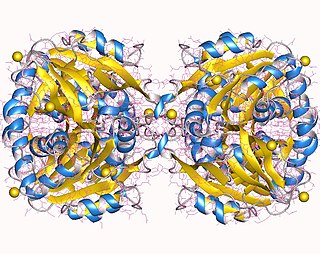A dehydrogenase is an enzyme belonging to the group of oxidoreductases that oxidizes a substrate by reducing an electron acceptor, usually NAD+/NADP+ or a flavin coenzyme such as FAD or FMN. Like all catalysts, they catalyze reverse as well as forward reactions, and in some cases this has physiological significance: for example, alcohol dehydrogenase catalyzes the oxidation of ethanol to acetaldehyde in animals, but in yeast it catalyzes the production of ethanol from acetaldehyde.
A hydrogenase is an enzyme that catalyses the reversible oxidation of molecular hydrogen (H2), as shown below:

Biohydrogen is H2 that is produced biologically. Interest is high in this technology because H2 is a clean fuel and can be readily produced from certain kinds of biomass, including biological waste. Furthermore some photosynthetic microorganisms are capable to produce H2 directly from water splitting using light as energy source.
Hydrogen-oxidizing bacteria are a group of facultative autotrophs that can use hydrogen as an electron donor. They can be divided into aerobes and anaerobes. The former use hydrogen as an electron donor and oxygen as an acceptor while the latter use sulphate or nitrogen dioxide as electron acceptors. Species of both types have been isolated from a variety of environments, including fresh waters, sediments, soils, activated sludge, hot springs, hydrothermal vents and percolating water.
A hydrogenase mimic or bio-mimetic is an enzyme mimic of hydrogenases.

In enzymology, a 2-alkenal reductase (EC 1.3.1.74) is an enzyme that catalyzes the chemical reaction
In enzymology, a 4-methoxybenzoate monooxygenase (O-demethylating) (EC 1.14.99.15) is an enzyme that catalyzes the chemical reaction
In enzymology, a deoxyhypusine monooxygenase (EC 1.14.99.29) is an enzyme that catalyzes the chemical reaction
Ecdysone 20-monooxygenase (EC 1.14.99.22) is an enzyme that catalyzes the chemical reaction
In enzymology, an estradiol 6beta-monooxygenase (EC 1.14.99.11) is an enzyme that catalyzes the chemical reaction
In enzymology, a coenzyme F420 hydrogenase (EC 1.12.98.1) is an enzyme that catalyzes the chemical reaction
In enzymology, a cytochrome-c3 hydrogenase (EC 1.12.2.1) is an enzyme that catalyzes the chemical reaction

In enzymology, ferredoxin hydrogenase, also referred to as [Fe-Fe]hydrogenase, H2 oxidizing hydrogenase, H2 producing hydrogenase, bidirectional hydrogenase, hydrogenase (ferredoxin), hydrogenlyase, and uptake hydrogenase, is found in Clostridium pasteurianum, Clostridium acetobutylicum,Chlamydomonas reinhardtii, and other organisms. The systematic name of this enzyme is hydrogen:ferredoxin oxidoreductase
In enzymology, a hydrogen dehydrogenase (EC 1.12.1.2) is an enzyme that catalyzes the chemical reaction
In enzymology, a hydrogen dehydrogenase (NADP+) (EC 1.12.1.3) is an enzyme that catalyzes the chemical reaction
In enzymology, a hydrogen:quinone oxidoreductase (EC 1.12.5.1) is an enzyme that catalyzes the chemical reaction
In enzymology, a Methanosarcina-phenazine hydrogenase (EC 1.12.98.3) is an enzyme that catalyzes the chemical reaction
In enzymology, a glycine dehydrogenase (cyanide-forming) (EC 1.4.99.5) is an enzyme that catalyzes the chemical reaction
An enzymatic biofuel cell is a specific type of fuel cell that uses enzymes as a catalyst to oxidize its fuel, rather than precious metals. Enzymatic biofuel cells, while currently confined to research facilities, are widely prized for the promise they hold in terms of their relatively inexpensive components and fuels, as well as a potential power source for bionic implants.
Hydrogenase (NAD+, ferredoxin) (EC 1.12.1.4, bifurcating [FeFe] hydrogenase) is an enzyme with systematic name hydrogen:NAD+, ferredoxin oxidoreductase. This enzyme catalyses the following chemical reaction



